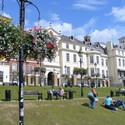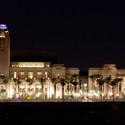for the better part of a century, the architectural discussion was dominated by modernism and other related forms of Futurism and functionalism. For some, this constant invocation of the new radically began to look a little tired. In the 1980s looking backwards for inspiration brought us famous adaptive populist and postmodernist but also emerging at that time was new classical architecture, which completely rejected any continuity with modernism and returned instead traditional rules. In the years that followed, New Classical architecture has evolved into a resurgence of pre-modern forms, with the term also incorporating designs that have never been considered "classical" in the first place - including Gothic and historicist styles non-Western. We've rounded up some of the most amazing, interesting - even high-tech -. New examples of classical architecture after the break

.jpg?14292001)

 14
14
Whitman College, Princeton 02
Funded by eBay CEO Meg Whitman's building Demetri Porphyrios College was chosen to continue the Gothic style of the late 19th century Princeton expansion as it has become university, it is today.The college uses a variety of different stylings within the complex, the formation of a community building which is supposed to reflect the learning community within the University. The college is unified by the common language of the Gothic Revival, a unit that defenders of New Classical architecture argue is more difficult to achieve in a contemporary style.
Oxford Centre for Islamic studies, Oxford, 2013
Proving that New Classicism not to not be backwards-looking, Center Abdel-Wahed El-Wakil for Islamic studies combines classical Islamic forms with the traditional style of Oxford colleges, reflecting the common heritage of Islamic studies and the University of Oxford. Islamic vernacular and crafts placed in a Western classical context such harmony is a statement of the place of Islam in the modern world in the UK and is an example of how the forms and rules classic can be used to create something truly progressive.
Schermerhorn Symphony Center, Nashville, 06
status Nashville as the "Athens of the South" was confirmed by the addition of Symphony Center David M. Schwarz, a technologically advanced venue with careful acoustic design and flexibility granted by the main hall easily reconfigurable, enabling the raked seats be converted to a flat floor, allowing many uses of space. The long history of classical form and the Greek imitation in Nashville will soften the incongruity of the room, but the heavy reliance on imitation other Vienna concert halls in Amsterdam lacks the sense of place that Schermerhorn was intended to evoke.
Smith Center for the Performing Arts, Las Vegas, 09
the first center for the performing arts in the United States to be classified as Silver by the US Green building Council, David M. Schwarz has chosen to create a sustainable innovative building that echoes Hoover Dam Nevada as a way of echoing longer history of Las Vegas pastiche and imitation. Like his earlier Symphony Center, the clean lines and ornate decoration of the center are wound around the acoustic engineering of advanced, energy-efficient equipment and recycled materials that make this building both a reflection of great history of Las Vegas showing a sustainable future.
Richmond Riverside, London 1987
the always controversial Quinlan Terry was one of the first practitioners of New classical architecture as a distinct movement in the 1980s, and became a favorite of the establishment of the United Kingdom. Both criticized and praised for its tendency to take the rules of classicism slightly, Richmond Riverside is a playful development and "restoration" to stay old buildings using lightweight Terry to create a highly flexible set of buildings that heavily weighted in pastiche. That said, the depth of knowledge on traditional methods allowing Terry to break all these rules also gives him a great understanding of the material and scale, creating a dense and economic development as contemporary styles might have struggled with .
Edificio Artklass, Bilbao, 2011
from the Guggenheim Museum has triggered many architectural boom documented Bilbao, the city has been working dotted with the great and good of the avant-garde architecture, but Robert Krier and Marc block Breitman is an attempt to echo the traditional style of the Ensanche district of Bilbao, which results in a more local flavor without sacrificing modernity. The 180 apartments in the six building facade are designed to give people a greater sense of the contemporary buildings.
Posting Komentar